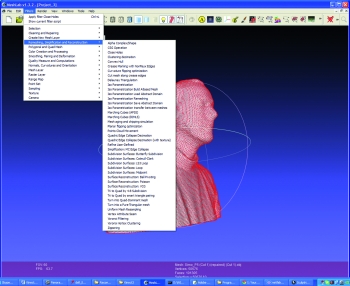
A good rule of thumb is to stay below 1 million triangles. Details that are below the resolution won't get printed anyway, so don't bother sending them to your printer. Keep the printer resolution in mind when deciding on the polygon count.

Polygon threshold - the maximum number of polygons the printer can handle.
#MESHLAB CREATE SHELL FULL#
For full color, you'll usually have to provide a VRML file with the required vertex colors or UV maps. For 'monochrome' printers, the STL file is fine. Only a few can handle full color like the ZCorp or Visijet printers. Again, check with your printer to see if you can add supports.įull color support - Most printers these days print in one material. A large overhang will require adding support material. Some printers, especially FDM printers (like Ultimakers or Makerbots), have a limit to the 'angle' of some of the faces. Wall thickness and Model size - Does your model conform to your printer's minimum thickness (the thinnest part it can print), and will it fit in the print area? Each printer has it's own minimum and maximum model sizes, be sure to check them! For even more information, including fun non-orientable (and unprintable) surfaces, check out the Wikipedia page on Manifold. For more information on this topic, see this excellent tutorial on Shapeways.

If yours doesn't, try the free Meshlab software. Most 3D apps have support for testing manifoldness. Basically, it confirms that the surface can exist in reality - the main requirement being that each edge should be connected to exactly two faces. This is a mathematical term describing object surfaces. Manifold - Related to the concept of watertightness is ' manifold'.

So take care to close your model! Of course you can still have models with holes in them, like a donut, but make sure that the surface is continuous and closed. Watertight - Is your model ' watertight'? 3D printers get confused if there's a 'leak' in your model - essentially this would reduce the model to a two-dimensional shell. Most 3D applications can export to STL so it's easy to convert a model that you downloaded from Sketchfab. These points may vary between different printers, so it's always best to check with the manufacturer!įile format - What kind of file format does your printer require? Most printers will accept STL files, although commercial services can work with a wider range of file types (e.g.
#MESHLAB CREATE SHELL DOWNLOAD#
However, because you can only download the author's original files, some models will need a bit more work before printing. Some files are ready to print right away. You might want to download a model to 3D print it on your own printer or a printing service like Shapeways.


 0 kommentar(er)
0 kommentar(er)
